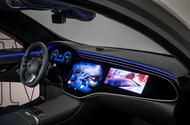Physical buttons are not on the company’s agenda, as it pushes further away from traditional user interfaces
Mercedes models will offer more and even larger screens in their interiors over the coming years.
The firm’s chief technology officer, Markus Schäfer, told Autocar at CES in Las Vegas that Mercedes is still “on a trajectory where you see even more screens in the car”, at a time when some competitors are scaling back on ever-larger touchscreens in favour of a return to more physical buttons.
Mercedes has introduced the so-called MBUX Hyperscreen into some of its electric cars, including the Mercedes EQS, and this seamless, pillar-to-pillar screen is what Schäfer sees as being rolled out across more models in the future.
“Mercedes will go to seamless screens from left to right. That’s the next evolution,” he said.
He described this screen as a “really stunning experience” and a huge development over the separate bonded screens behind glass. “I think this screen is a very essential part for us, at least for the next couple of years.”
The firm will look to continue to use OLED technology from LG to ensure a high-quality display. The screen itself is more than 1.4m wide.
Schäfer doesn’t see any alternative to such screens, and while the firm has investigated more augmented reality projection through the windscreen, he considers these to have “many downsides”.
“That’s why our way is clearly working with high-quality screens,” he said. “New technologies are coming up for a really seamless experience and we are going to be using gaming engine technology to make it even more attractive and create stunning visualisation for us to be really immersive.”
Schäfer also confirmed a wider roll-out of AI within Mercedes cars, after a beta trial of using ChatGPT in models in the US last year. Mercedes also announced at CES a new AI virtual assistant that a driver will be able to communicate with and carry out commands in the car.
However, in the case of ChatGPT, Schäfer said Mercedes is having to watch closely what it tells drivers because “if it tells you something that’s absolutely nonsense, you might be exposed to product liability cases because you’re in a moving object, not like when you’re sat with your smartphone asking something”.
Source: Autocar
